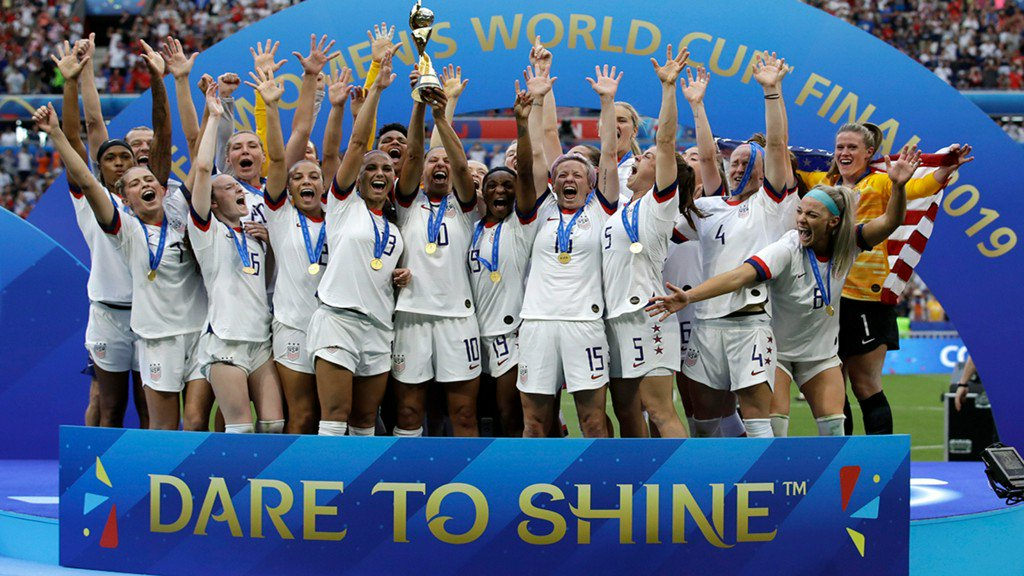U.S. Women’s Team World Cup Win Renews Fight Over ‘Pay Equity’
The victory of the U.S. Women's team in the World Cup has renewed a long-standing argument over pay equity, but the issue is far more complicated than it seems.

Yesterday’s World Cup victory by the U.S. Women’s National Team, capping off a tournament in which they outscored their opponents 26-3 over the course of seven matches, has revived the debate about the pay disparity between the U.S. Men’s National Team and their much more successful female counterpart:
The US Women’s National Team sealed the deal with its fourth stunning victory Sunday at the World Cup, but the players are still fighting another battle back home. The soccer team’s 2-0 victory against the Netherlands proved that the US women are still at the top of the game — and, the athletes say, that they should be paid as equal to men.
“At this moment of tremendous pride for America, the sad equation remains all too clear, and Americans won’t stand for it anymore. These athletes generate more revenue and garner higher TV ratings but get paid less simply because they are women,” said Molly Levinson, spokeswoman for the USWNT players in their equal pay lawsuit.”It is time for the Federation to correct this disparity once and for all.”
In March, 28 members of the USWNT sued the US Soccer Federation for allegedly discriminating by paying the women less than members of the men’s national team “for substantially equal work and by denying them at least equal playing, training, and travel conditions; equal promotion of their games; equal support and development for their games; and other terms and conditions of employment equal to the MNT.”The soccer federation and the plaintiffs last month tentatively agreed to mediation, which is expected to begin now that the World Cup is over
(…)
The prize for the 2018 men’s World Cup stood at $400 million, while female players will receive $30 million this year. FIFA President Gianni Infantino said the organization will double it for the next women’s World Cup in 2023, but Rapinoe said there still would be a long way to go.”It certainly is not fair,” she said. “We should double it now and use that number to double it or quadruple it for the next time.”
The New York Times notes that the fact that the U.S. Women’s team won its match on the same weekend that the men’s team lost its match in the Gold Cup tournament is also likely to renew the equal pay debate:
For American soccer fans, the juxtaposition was hard to ignore: the United States women’s team winning a record fourth World Cup championship in France, its men’s counterpart falling to its bitter rival Mexico hours later in a regional championship in Chicago.
The two results Sunday were not a mere collision of games: they also highlighted a contentious battle about pay equality featuring the men’s teams and women’s teams, the different media and financial ecosystems in which they compete, and the often unequal rewards for success for male and female athletes. All of it was brought to the fore again by the women’s team’s latest world championship, and by the chants of “Equal Pay!” that serenaded the players after they won.
In recent years, that fight for pay equality has been the women’s team’s calling card. The players contend they are paid less by the United States Soccer Federation than the men — sometimes tens of thousands of dollars or more for top players in a given year — and that the situation has persisted for years even as the women’s team has collected more trophies and begun to produce more revenue than the men. U.S. Soccer has welcomed the team’s success — Sunday’s title was the team’s second in a row — even as it has challenged the players’ math, arguing that the situation is complicated by a compensation structure negotiated by each team that pays the men and women differently.
But the women’s players, who include some of the most prominent female athletes in the world, have pressed their argument in interviews and on social media and, most recently, in a gender discrimination federal court. On Sunday, bathing in the crowd’s adoration and set to cash in on bonuses of more than $250,000 each, one of their captains turned the screws again.
“I think we’re done with: Are we worth it? Should we have equal pay? Is the market the same? Yada yada,” the American midfielder Megan Rapinoe said, adding: “We — all players, every player at this World Cup — put on the most incredible show that you could ever ask for. We can’t do anything more, to impress more, to be better ambassadors, to take on more, to play better, to do anything. It’s time to move that conversation forward to the next step.”
Yet the basics of the United States team’s financial arrangement with U.S. Soccer will not change immediately, decades of inequity hardly wiped clean with a flurry of goals. The team’s collective bargaining agreement, which sets the players’ salaries and working conditions, runs through the end of 2021, and the players are explicitly forbidden from engaging in a strike over its terms. Some of U.S. Soccer’s partnerships, with Nike and with television networks like ESPN and Fox, have years to run, and since they bundle all the national teams together, assigning a value to one or another is impossible.
Still, the women’s team’s activism has produced results. U.S. Soccer agreed to a new collective bargaining agreement with its women’s players two years ago that included higher salaries, richer bonuses and improved working conditions. And other countries have followed that lead: the Netherlands, the rising power that lost to the Americans in the World Cup final, has set a goal of pay equity for its men’s and women’s teams by 2023.
Last year, FIFA doubled the prize money for this summer’s Women’s World Cup, to $30 million, and last week its president, Gianni Infantino, pledged that he would seek to double it again in time for the next edition in 2023. (The women’s total bonus pool remains a fraction of the $400 million that the 32 men’s World Cup teams — which for the first time in a generation did not include the United States — split in 2018.)
On its face, the pay disparity between the men’s and women’s teams is certainly surprising and the comparative success of the two teams over the years just makes the disparity seem more unfair. This is especially true given the fact that Sunday’s win constituted the second-consecutive World Cup win for the women’s team, it’s fourth overall, and the seventh time in the 28 year history of the tournament that the team has finished in the top three. By contrast, the U.S: men’s team failed to even qualify for the 2018 World Cup and has never finished in the top four in that tournament in the years that it did qualify with the exception of the first World Cup in 1930. However, as the fact-checkers at The Washington Post note, the question of whether or not there even is a pay gap between the two teams isn’t an easy one to figure out:
The Fact Checker obtained the new agreement, which took effect in April 2017. Using the same 20-game scenario, we calculated the player on the women’s team would earn $28,333 less, or about 89 percent of the compensation of a similarly situated men’s team player. If both teams lost all 20 games, the players would make the same amount. That’s because the men earn a $5,000 bonus when they lose and the women have a $100,000 base salary.
USWNT players have previously said publicly they believed this was the best agreement they could get without going on strike. McCann said: “The players’ unions negotiated these systems. This type of argument thus implicitly directs USWNT players to blame their own union for negotiating a system that pays them in ways they find unacceptable.”
Under the women’s new bargaining agreement, the players can also earn attendance bonuses, payment for commercial appearances and per diems that are equal and tied to what the men can earn.
(…)
When it comes to revenue from games, the women’s national soccer team has held its own against the men’s team since the 2015 World Cup win. But games account for only one-quarter of USSF revenue. Sponsorships make up half, and it’s hard to determine what the women’s team contributed to USSF without more data.
Are the women players paid less? Sometimes. When the female players have appeared to make about the same or more money, they’ve had to turn in consistently outstanding performances on the world stage. Even with those feats, earning the same amount as the men’s soccer players was near-impossible under the previous collective-bargaining agreement.
The new agreement has provisions that may reduce the difference in bonuses for friendly games and tournaments, but there is — without question and for whatever reasons — still a massive gap between men’s and women’s World Cup bonuses.
I recommend reading the entire piece. In some areas, it does appear to back the claim of the women’s team that they are being paid less than the men’s team. However, to some extent that is due either to the terms of the applicable collective bargaining agreements, which are different for each team, and the revenue from which the U.S. Soccer Federation can draw in paying the teams and the players, especially with regard to games related to their respective World Cup bids. In that case, it’s worth noting that the men’s tournament generates far more revenue and interest worldwide than the women’s tournament does. While it is true that Sunday’s final game of the women’s tournament drew more viewers in the United States than the 2018 final, that’s likely because there was an American team involved in the game. In terms of worldwide viewership, though, the men’s tournament dwarfs the women’s tournament by orders of magnitude. The 2018 final, for example, is estimated to have drawn some 3.4 billion viewers worldwide. While similar numbers aren’t available for Sunday’s game as of yet, the general worldwide viewership for the game is likely to be much lower. (Indeed, it’s worth noting that several camera shots of the venue where the women’s final was played showed empty seats, something that would not happen for the men’s tournament.)
When one actually looks at the facts it seems fairly clear that there is a logical explanation for the disparities between the men’s World Cup and the Women’s World Cup. The biggest difference, of course, is that the World Cup, which I will use to refer specifically to the men’s tournament next scheduled to be held in 2018, draws far more worldwide viewership and, thus, far more, sponsorship money, than the women’s does. This will likely always be the case regardless of whatever arguments one might make regarding comparisons of the quality of play between the two games, but in time it’s likely that the women’s game will gain more of a following worldwide, which will lead to better broadcasting deals and likely better revenue sharing for the teams and the players. Additionally, given that this is FIFA we’re talking about, I won’t rule the possibility that corruption plays a role in all of this. Nonetheless, the fact that the men’s tournament gets far higher worldwide viewership than the women’s tournament is something that can’t be denied, and it’s the main reason why the women’s tournament generates far less money.
A.G. Hamilton at National Review makes a similar argument:
In reality, relative to the men’s World Cup, it was actually the women’s teams that were being paid a much larger share of what they brought in. While these articles noted that the U.S. women’s team brings in more money than the men’s team, they all managed to ignore the more-relevant disparity in revenue: The men’s tournament brought in over $6 billion in revenue in 2018, while the women’s tournament is estimated to only have brought in $131 million in 2019. The prize pools are taken from those revenue totals. In other words, the women’s prize pool was approximately 23 percent of their total revenue, while the men’s prize pool consisted of approximately 7 percent of revenue. The winning men’s players received only about four times as much as the winning female players, despite bringing in over 45 times as much revenue. These numbers should make it obvious that there is no substantive case that the women’s team is underpaid relative to their male counterparts, but the media managed to ignore those facts.
This pay disparity isn’t just limited to the World Cup, of course, nor is it limited to soccer. It can be seen all across professional sports, and again the answer can be found in the fact that the team sports that feature men generally make a lot more money than the team sports that feature women. This is true in basketball, where NBA essentially subsidizes the existence of the WNBA in no small part because it helps with the leagues marketing to female fans. It is also true in professional soccer, where Major League Soccer has been quite successful over the past decade while one women’s professional league after the other has collapsed largely due to non-interest, low attendance, and a lack of interest from broadcasters and advertisers, from whom a majority of the money that goes into the pot that the teams are paid from actually comes. These differences exist largely because of the choices that fans and viewers make, and to ascribe them to sexism or discrimination as some people have is really quite absurd.
While I’m not a fan of the game, the U.S. women deserve much credit for their victory on Sunday and they deserve as much money as they can get. In that regard, they are currently engaging with mediation with the U.S. Soccer Federation that is supposed to address these alleged pay disparities. Additionally, it’s worth noting that, unlike the men’s team, the women’s team in the United States retained much of the merchandising rights, which in and of itself is likely to be a significant source of revenue in the wake of Sunday’s World Cup win. The men’s team does not have a similar provision in their agreement with the USSF.
Additionally, in some sense, the success of the two teams is not a relevant measure to look at in the pay disparity debate. The women’s team is successful largely because the United States is so dominant in women’s sports such as soccer and because other nations are only beginning to catch up in that area. As I noted on Sunday, this is largely due to the success of Title IX and other similar provisions of the law. The men’s team, by contrast, is playing a sport which is exceedingly popular all around in the world and in which the level of world-class play is far greater than they are often able to compete with. Most of the stars of women’s soccer around the world are from the United States, whereas the stars of the men’s game come from nations such as Brazil, Argentina, Germany, the United Kingdom, and Spain, where the game is played at an entirely different level. I don’t think there’s any doubt that if the women’s team were to play the same opponents the men’s team does that their record of success would not only not be better, but that it would be significantly worse. Using wins and losses to make a point about pay equity, therefore, is a classic apples vs. oranges comparison.
The women’s team deserves all the credit and laudatory celebration they are getting for their win. And if they can leverage that into better pay from the USSF, then more power to them. However, the pay disparity that exists now is neither illogical nor, when you look at the relevant evidence, unfair.






Rather than beg FIFA for more money, the women should dump FIFA entirely, just as Billie Jean King and the superstars of Women’s Tennis dumped the US Tennis Association when that organization refused to treat them with respect and fairness. FIFA is even worse, since it is hopeless and clownishly corrupt. Better to remove themselves from such an organization at this early stage than to become an even bigger part of it.
You can’t “dump FIFA” if you want to participate in the World Cup.
Why not return to a time when these events did not pay salaries to the players? Only expenses were paid. It needs to be amateur status, not professional.
The television games overall are low on viewer numbers: typical score is 2 – 1, or 1 – 0. The field looks like it is a mile long. Some of the rules are confusing and the game time seems to be a mystery.
Baseball and car races are more exciting.
Let me get this straight. The women’s team has succeeded time and again on the world stage in a way the men haven’t come close to, and you say it’s because the women have a leg up on the competition while the men will never be able to compete because the competition is sooooo much better than they are and always will be. Maybe it’s just because the women on our soccer team are *better athletes* than the men on our soccer team are?
And yet you still think we should pay the men more. I always thought libertarians were about results first.
**there is a reason why our men’s teams don’t match up on the world stage: Our best athletes go into football, basketball, and baseball where the money is. A Lionel Messi will never arise on a US soccer pitch.
@Tyrell:
You probably watch scrabble tournaments on TV.
@Doug Mataconis:
Sure. And for the men that would be a non-starter. But do you think the Women’s quadrennial championship would get any fewer viewers if it was called the “Women’s World Championship” rather than the “Women’s World Cup”? If it had the US, France, England, The Netherlands, Japan and a few others I bet 70% wouldn’t even realize there had been a change and the remaining 30% would be in favor. It’s the World Championship that matters. FIFA brings nothing significantly positive to the Women’s game.
@OzarkHillbilly:
Possible I suppose but if both teams played against each other I’d give the advantage to them men.
@MarkedMan:
FIFA also runs the Women’s World Cup as well as the various regional tournaments that the national team competes in.
@Tyrell: Soccer is as exciting as any other sport, actually.